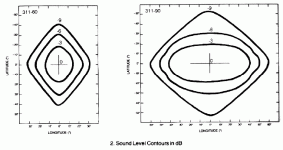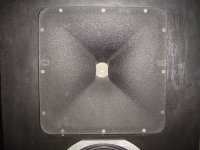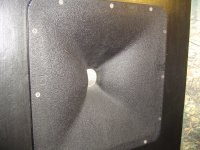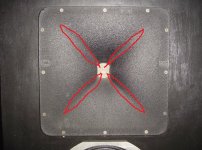They might not have any backlog anymore, I dunno, that was quite a while ago. I just meant you should check. I don't think comparative measurements are available, as far as the freq. range.
Start a new thread on the build.....you'll get more replies and help as its on topic. I'll add that it's not a big concern where center to center spacing is concerned with these designs.....acoustic centers or setback are far more important.....these larger designs are usually listened to at longer distances, allowing for the drivers to blend sufficiently. Also, for the same reasons the JBLs graphs look so good, the QSC guide maintains directivity lower than the SEOS allowing for a lower XO point.....and farther C to C spacing. It's choosing the appropriate compression driver that can play that low becomes the challenge. Obviously the B and C DE250 has been proven by Geddes to 900hz. There are others, but the non metallic diaphram of the DE250 presents a smoothness unmatched by the metallic diaphrams.....subjectively speaking.
I was post 1. It was somewhat of a leading question, as I believed it may naturally elicit some good points on prospective horns, and their performance. It did. I will start a separate build thread as well when the parts arrive. I am leaning towards the DE250 or its copycat, the Denovo360.
Back on topic. Wayne suggest in his paper that 90-40(60) is ideal dipersion for home environment. Do others agrees or is the OBS waveguide(DDS/Geddes) a more ideal approach. FWIW, I am a hifi guy who watched TV occasionally. THis is more about music for me than HT.
Just so that you know, I do not agree with the non-axisymmetric point of view. They point out all the advantages but ignore the downsides. All told I think that matching directivities between the woofer and waveguide is the better choice.
Look at one of those square waveguides across the diagonal. They are pretty bad along that axis. Axisymmetric are same along any axis - a huge advantage.
Look at one of those square waveguides across the diagonal. They are pretty bad along that axis. Axisymmetric are same along any axis - a huge advantage.
Back on topic. Wayne suggest in his paper that 90-40(60) is ideal dipersion for home environment. Do others agrees or is the OBS waveguide(DDS/Geddes) a more ideal approach. FWIW, I am a hifi guy who watched TV occasionally. THis is more about music for me than HT.
What does the 90-40(60) mean, I think 90x40 horn, but why the 60 in (). Just asking to clarify. There are alot of 90x40, 60x40 options along with others, the tough problem for me is finding one that goes down below 400 hz.
I still agree with Geddes that a big part of this was likely marketing. The cheap PT waveguides measure pretty darn good.
Hello,
I don't have a definitive take on that but what I see is the presence of beaks in that new JBL horn.
http://www.jblpro.com/products/recording&broadcast/M2/images/Tech_R4C1.jpg
IMHO those beaks are here to control the distribution of the sound level on the surface of the wavefront emitted by the "rectangular type" horn.
See attached the distribution of the sound level on the wavefront of a rectangular horn Altec 311. Even if the 311 is a multisectorial horn it belongs to the rectangular type. You can see that the outer limit of the sound level is not rectangular but possess a diamond shape.
IMHO the beaks along the midline of the 4 walls of the JBL horn are here to ensure a more elliptical or rectangular distribution of the sound level over the front wave.
Such beaks are also used to control horizontal directivity on the Sony horn which is used in Studio MOnitors using the magnificent SUP-T14 compression driver:
http://www.audioheritage.org/vbulletin/attachment.php?attachmentid=13498&stc=1&d=1141815765
and on my E-JMLC horns (that several audiophiles consider as the best horn they could listen to, ever) :
Horns
And those beaks are not only there to make the horn looking good!
Best regards from Paris, France
Jean-Michel Le Cléac'h
Attachments
Last edited:
What does the 90-40(60) mean, I think 90x40 horn, but why the 60 in (). Just asking to clarify. There are alot of 90x40, 60x40 options along with others, the tough problem for me is finding one that goes down below 400 hz.
down below 400 is tough and will probably require loading a 5-8" midbass driver. Others may say differently. You are correct about the 90x40. There are some 90x60 and 80x60 horns I have looked at.
Hi Jean Michel,
I've been wondering about their modified design as well. What you call the beaks are the normal profile for a JBL biradial. That is, the the beaks over the dome are creating a diffraction slot with a narrower cross section to maintain pattern control to a higher frequency. I think the exact horizontal and vertical cross section slices would be classic biradial.
Then they have cut troughs into the diagonal intersections between H and V profiles. It is probably, as you say, a detail to get wider dispersion on the diagonals of the issobars. I don't know if they have published info on this or not.
I also see it on the newer cinema horns that have a rounded trough down the 4 diagonal edge.
David S
I've been wondering about their modified design as well. What you call the beaks are the normal profile for a JBL biradial. That is, the the beaks over the dome are creating a diffraction slot with a narrower cross section to maintain pattern control to a higher frequency. I think the exact horizontal and vertical cross section slices would be classic biradial.
Then they have cut troughs into the diagonal intersections between H and V profiles. It is probably, as you say, a detail to get wider dispersion on the diagonals of the issobars. I don't know if they have published info on this or not.
I also see it on the newer cinema horns that have a rounded trough down the 4 diagonal edge.
David S
Hi Jean Michel,
I've been wondering about their modified design as well. What you call the beaks are the normal profile for a JBL biradial. That is, the the beaks over the dome are creating a diffraction slot with a narrower cross section to maintain pattern control to a higher frequency. I think the exact horizontal and vertical cross section slices would be classic biradial.
Then they have cut troughs into the diagonal intersections between H and V profiles. It is probably, as you say, a detail to get wider dispersion on the diagonals of the issobars. I don't know if they have published info on this or not.
I also see it on the newer cinema horns that have a rounded trough down the 4 diagonal edge.
David S
Hello David,
For me the shape of the walls of that horn is different than the simpler one of the biradial horns.
For sure the biradial have bicurvature walls but here there is a kind of median ridge, that I improperly may call "beaks".
For what it seems there is no overlaping of those ridges or beaks on the first axisymetrical part of the horn.
IMHO, due to the height of those ridges at the throat, the diffraction effects are minimized. It operates as with the wing of the A2 Spirit airplane.
http://www.atfx.org/photos/b2a.jpg
That's why I maintain that this shape was created to have a better control of the distribution of the sound level on every wavefront.
Best regards,
Jean-Michel Le Cléac'h
Hello David,
For me the shape of the walls of that horn is different than the simpler one of the biradial horns.
For sure the biradial have bicurvature walls but here there is a kind of median ridge, that I improperly may call "beaks".
For what it seems there is no overlaping of those ridges or beaks on the first axisymetrical part of the horn.
IMHO, due to the height of those ridges at the throat, the diffraction effects are minimized. It operates as with the wing of the A2 Spirit airplane.
http://www.atfx.org/photos/b2a.jpg
That's why I maintain that this shape was created to have a better control of the distribution of the sound level on every wavefront.
Best regards,
Jean-Michel Le Cléac'h
Its all a bit relative and you can think of the profile as starting with the lower profile and building up or starting with the upper profile and cutting away. I strongly see the conventional JBL contours in the raised areas away from the diagonal corners, so to me it seems like they started with a conventional biradial profile, much as the one Rob just posted, and cut troughs into the diagonal intersections of the usual biradial surfaces.
I've put some crude lines on Robs picture to illustrate.
As you speculate, this gives a wider profile along the diagonal and should stretch out the beamwidth along those lines, thus improving the isobar.
Viewed that way the "beaks" are the vestiges of the usual diffraction slot, as all the Biradials have. It gives a narrow starting point to the horizontal profile and holds the beamwidth to a higher frequency.
David S.
Attachments
Last edited:
Here are pictures of the PTH1010 A 100X100 waveguide now discontinued. There seems to be a resemblance. The M2 horn looks like the next step to me.
Rob🙂
These are classsic Biradial with the usual warping to make them work as a flat front design. They have the usual straight sides curving to an end flare and as such are modified conical.The detail by the throat is just a small amount of diffraction slot (some versions such as the big theater horns and the 2344 have a deep diffraction slots, these are quite shallow but do the same thing). It just allows the lateral profile to be fed from a narrower starting dimension to maintain beamwidth to a higher frequency.
The big M2 horns look more like the Older EV white horns to me. They have the taller aspect ratio so that they can hold their beamwidth down to similar frequencies both horizontally and vertically, as per the first generation Manta Ray designs.
To understand these and any other CD designs you should read Don's EV and JBL papers, and the Altec Manta Ray paper. Then a lot of the profiles will make more sense.
Of course my horn knowledge is old and obsolete...
David S.
Hello David
Thanks I will check it out.
Don Keele as you probably know has a really nice site with his papers linked. Here is I think the original EV paper. He is one busy guy!! Don's two papers for the 2 JBL horns as there as well. Don't know where the Altec Manta Ray Paper is?? Anyone post a link??
http://www.xlrtechs.com/dbkeele.com/PDF/Keele (1975-05 AES Preprint) - Whats So Sacred Exp Horns.pdf
Huh?? OK
Rob🙂
The big M2 horns look more like the Older EV white horns to me
Thanks I will check it out.
Don Keele as you probably know has a really nice site with his papers linked. Here is I think the original EV paper. He is one busy guy!! Don's two papers for the 2 JBL horns as there as well. Don't know where the Altec Manta Ray Paper is?? Anyone post a link??
http://www.xlrtechs.com/dbkeele.com/PDF/Keele (1975-05 AES Preprint) - Whats So Sacred Exp Horns.pdf
Of course my horn knowledge is old and obsolete...
Huh?? OK
Rob🙂
Last edited:
http://alteclansingunofficial.nlenet.net/publications/techletters/TL_241.pdf
I didn't see the Manta Ray paper on the web, although it is referenced in this application note (ref 2)
They basically reiterated what Don was saying about the EV units and added the notion that wide lateral, narrow vertical horns needed to be taller than they were wide to achieve matching LF bandwidth.
Note that the bulk of the revisions in the JBL style were just so that Don could get around his previous EV patents!
David S.
I didn't see the Manta Ray paper on the web, although it is referenced in this application note (ref 2)
They basically reiterated what Don was saying about the EV units and added the notion that wide lateral, narrow vertical horns needed to be taller than they were wide to achieve matching LF bandwidth.
Note that the bulk of the revisions in the JBL style were just so that Don could get around his previous EV patents!
David S.
Very interesting discussion!
Jean-Michel, have you published a spreadsheet for these horn profile calculations?
What I really would like would be to be able to set an horizontal curve (such as an OS curve for example), a "global" profile (tractrix of a given frequency, etc.), and let the software calculate the whole shape of the horn, letting the vertical curves be what it ever it takes to obtain the global profile with the horizontal curve as a constraint)
David, it is a shame that you don't post on the audioheritage forum (although there already is a member named "speaker dave" 😉 ). Your knowledge and insight would be much appreciated an really valuable there!
Jean-Michel, have you published a spreadsheet for these horn profile calculations?
What I really would like would be to be able to set an horizontal curve (such as an OS curve for example), a "global" profile (tractrix of a given frequency, etc.), and let the software calculate the whole shape of the horn, letting the vertical curves be what it ever it takes to obtain the global profile with the horizontal curve as a constraint)
David, it is a shame that you don't post on the audioheritage forum (although there already is a member named "speaker dave" 😉 ). Your knowledge and insight would be much appreciated an really valuable there!
Hello Dave
Thanks for the link to the Tech note. Ureda rang the bell. I forgot I had a copy of the patent.
Rob🙂
I didn't see the Manta Ray paper on the web, although it is referenced in this application note (ref 2)
Thanks for the link to the Tech note. Ureda rang the bell. I forgot I had a copy of the patent.
Rob🙂
Attachments
Why do so many of the jbl horns take a larger diamter throat and compress it down before opening up again into the horn/mouth area? Is it for greater loading of the driver. I noticed this about the H9800 horn as well. Wish I could find plans for that one.
The cross sectional area continues to expand from the throat diameter, the narrow diffraction slot allows dispersion to higher frequencies.Why do so many of the jbl horns take a larger diamter throat and compress it down before opening up again into the horn/mouth area?
- Status
- Not open for further replies.
- Home
- Loudspeakers
- Multi-Way
- JBL horn?



